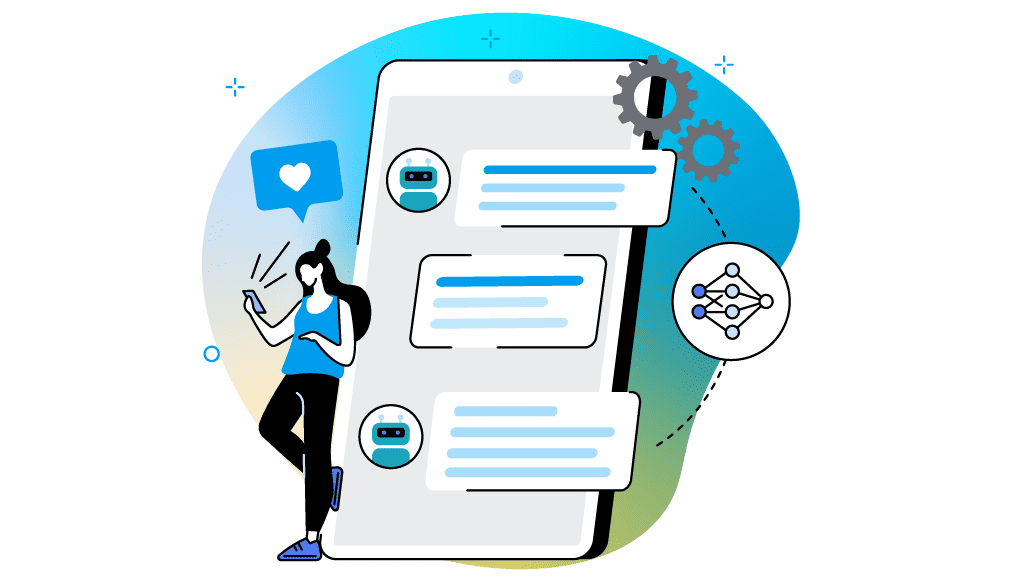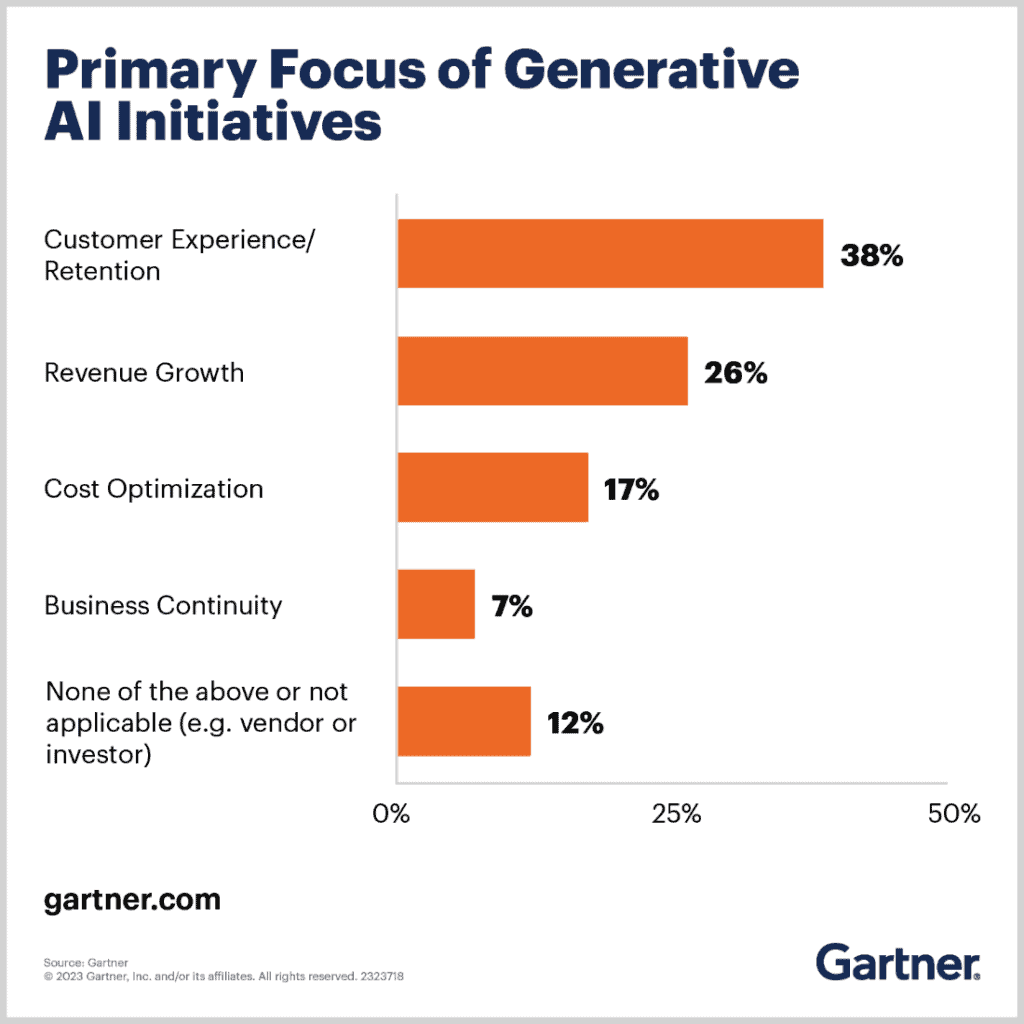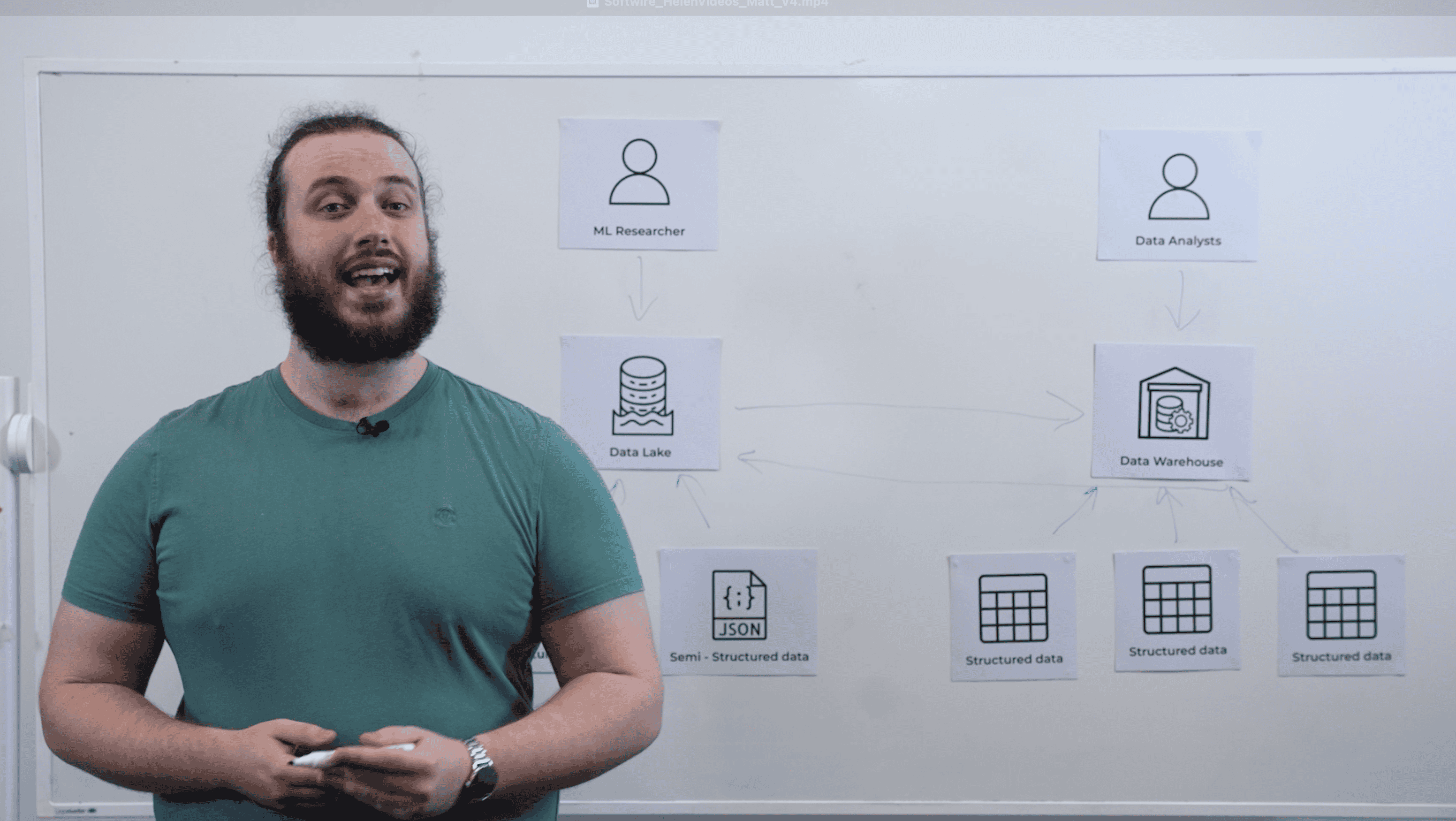
A 2023 study by the IBM Institute of Business Value found that 75% of CEOs believe that “competitive advantage will depend on who has the most advanced generative AI” and 50% are “now integrating generative AI into products and services”.
However, the buzz around Generative AI makes it hard for CEOs, Chief Product Officers and product leaders to discern which applications could support your future product strategy.
In this article, we aim to cut through the noise, presenting recent research that underscores the value of investing in Generative AI and showing you some inspiring ways that the market is using Generative AI.
Where is Generative AI helping companies the most?
2023 is being heralded as the breakout year for Generative AI. This subset of artificial intelligence, which uses data and large language models to autonomously produce content like images, text, and products, offers organisations great benefits in product innovation, customer experience, and market competitiveness.
Gartner’s webinar research of 2,500 executives found that 38% indicated that customer experience and retention is the primary purpose of their generative AI investments:

Customer experience and retention: A crucial way to increase customer experience and retention is to use Generative AI to create product and service enhancements that provide new features and functionality. to Using generative AI to enhance your products can ultimately mean your customers have better experiences and get better support. And research tells us that happy customers are more likely to stay loyal to your organisation, which has a direct impact on the business’s bottom line.
Revenue growth: There’s an expectation among customers that your product will be up-to-date, improved, and enriched using the latest technology, which is where generative AI can bring quick and easy gains.
What’s more, when you use generative AI with your own unique data and systems, you’ll get unique products or services, that your competitors can’t duplicate, which could help you dominate in your market.
Cost optimisation: With natural language processing tools like ChatGPT that use conversation to interact with the AI model, specialist knowledge of coding isn’t required anymore.
While generative AI could impact your organisational structure and processes and will require capital and strategic thought to align it with your vision and values, it is proving to bring about cost savings in process and headcount efficiencies.
This month, McKinsey found that one-third of its global survey respondents said their organisations were using generative AI regularly in at least one business function, while 40% of respondents said their organizations will increase their investment in AI overall because of advances in generative AI.
Business continuity: This is also primarily why generative AI investment can’t be avoided. If you’re not using generative AI and your competitors are, you’re giving them the perfect opportunity to distinguish their product above yours, which could steal away customer interest.
With generative AI maturity set to continue and companies taking advantage of its applications, the barrier to entry into your target market has been lowered, so now’s the time to make sure you understand what’s possible and how you can make your stand.
What’s possible with generative AI that wasn’t available with applied AI?
Applied AI, the use of AI technologies in real-world situations to create an immediate impact that benefits people, took AI out of the lab and into people’s workplaces.
Look at our applied AI work with Moorfields Eye Hospital and Google Deepmind. We built a bespoke, cloud-based data platform that transformed a catalogue of over 20 million eye scans into a format suitable for AI models to use. This led to an AI model capable of predicting whether an eye scan would indicate a condition within a six-month period of initial assessments.
Yet, with Generative AI, we have a whole set of levels opening up to us:
- On a basic level, organisations can use open AI technology like ChatGPT, a large language model chatbot by OpenAI, to simply input data as the prompt for processing and output the results through the product, like a simple chatbot.
- With more fine-tuning, AI product enhancement can be used for specific use cases. (Fine-tuning is a technique used in machine learning to improve the performance of pre-trained models on specific tasks, by training a pre-trained model with a new, relevant dataset.)
- Or generative AI tools can be combined with search tools, allowing for the weaving in of a company’s own proprietary data to give results that are specific to the organisation’s tone or data.
- Some large enterprise organisations will even create their own custom AI model, though this kind of project is expensive and resource-heavy, requiring large-scale computing power to process terabytes of data over a long period of time.
Five of the best examples of how companies are applying Generative AI to their services
There are a wide variety of applications that can be enhanced through generative AI. Here are just five of my picks to show you the range of what’s possible and why it works:
- Chatbots: The Bing search engine combines AI into its search functionality and responds in a chatbot format, Microsoft’s alternative to Open AI’s ChatGPT and Google’s Bard. Companies can also take advantage of creating customer support chatbots that are trained to do semantic searches on internal customer answers, searching a customer’s question with available keywords and data for relevance.
- Text editors: The text-editing company Grammarly is well known for its free spelling and grammar-checking features. It has recently introduced an AI service called GrammarlyGo, an AI communication assistant that has been trained on the user’s preferred writing style.
- Image generation: Adobe has long been one of the best-in-class creativity platforms that support illustrators and graphic designers alike. They’ve begun incorporating AI to support existing products, like Photoshop’s new Generative Fill feature that creates, amends, removes, or replaces images using simple text prompts powered by Adobe Firefly generative AI.
- Advanced research support: Research can now be made easier with Elicit, an AI search interface that uses language models to automate research workflows, like parts of a literature review. With the information that is gathered, Elicit can also brainstorm, summarise and classify text to support the research process.
- Code review: Most technical teams will have heard of Co-pilot, though there are two versions to know about. The one that offers excellent coding assistance to developers is GitHub Copilot. This AI developer tool has been used to support writing code, by suggesting lines and whole functions from the context of your work and the comments made. (The other is Microsoft Copilot, a productivity tool that combines your Microsoft 365 apps with your data to help you work smarter and faster.)
Making the leap between theory and application
There’s a lot of difference between hearing about ready-made tools that can help you carry out tasks and putting the power of Generative AI into action.
Sometimes you’re not even sure it can be done. When we worked with Tax Systems Limited, the leading provider of tax compliance software in the UK and Ireland, they weren’t sure they could leverage large language models to accurately automate manual, time-consuming accounting tasks that previously relied on expert human judgment. We quickly tested out our theories and proved that LLMs could be used to help their service work 20x faster.
It’s not easy to get the right talent together in-house. LinkedIn’s ‘AI at Work: Future of Work’ report tells us that businesses globally are hiring expertise in-house, with a remarkable 21-fold surge in English-language job postings referencing GPT or ChatGPT.
The first steps often involve simply testing – we recently spoke to several CTOs from a number of well-known organisations that share their learnings – and getting to understand your data. If you’re considering generative AI’s potential application in your industry or what strategic options would work best for you, speak to us about your ideas or tell us about your project.


